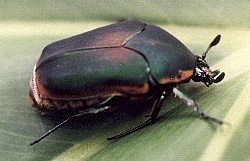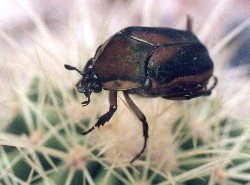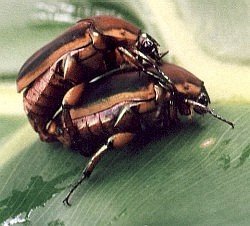Green June Beetle
by Valerie (November 9, 2002)
 Anybody who spends time out in their garden during the summer has undoubtedly encountered the green June beetle. Quite a bit bigger and more colorful than the little brown June beetles, this insect is not all that closely related. It is also called a fig eater because of its dietary preferences. While the small brown June beetles are nocturnal, often being attracted to outdoor lights, the green June beetle is diurnal, flying about and feeding during the day. They are not very accurate in flight and usually are noticed when their loud buzzing is stopped short because they have run into something.
Anybody who spends time out in their garden during the summer has undoubtedly encountered the green June beetle. Quite a bit bigger and more colorful than the little brown June beetles, this insect is not all that closely related. It is also called a fig eater because of its dietary preferences. While the small brown June beetles are nocturnal, often being attracted to outdoor lights, the green June beetle is diurnal, flying about and feeding during the day. They are not very accurate in flight and usually are noticed when their loud buzzing is stopped short because they have run into something.
The green June bug has a matte, or frosted, finish metallic covering on the top. It reflects green from some angles, but can also look gold or even rust colored. The head and underside are much more shiny. The odd, flat finish of the insects is sometimes scratched or marred, much like what happens with flat paint and a fingernail.
Green June beetles can be substantial pests to certain crops. The adults feed on fruits and corn, causing a lot of damage when they appear in large numbers. The grubs burrow in the upper layer of soil, feeding on humus and any organic matter they find. Contrary to popular belief, they eat very little of the roots of plants, but cause most of their damage by undermining seedlings, dislodging roots by digging, and causing the soil to dry out quickly. They are blamed for creating small bare patches in lawns which are then quickly colonized by weeds. Their foraging has much the same effect as that of moles. The grubs are on the large side and supposedly crawl about on their backs, although I've never noticed them try to crawl anywhere once they are exposed. When we have heavy rains our yard floods, forcing many subterranean creatures to the surface. I usually find the green June beetles when they have unceremoniously ended a flight with a crash landing. They seem to fly the most when they are looking for mates. I once heard one land in the grass behind me and, when I found it just a few seconds later, it was already mating with a female that had been there. I could tell the male had just flown in because he was still folding his wings up. The accuracy with which he homed in on the female was amazing, considering they usually just run into the side of the house. |

 I recently discovered that our dog has a taste for the grubs, which explains her eagerness to go outside and sniff around in the grass when we've had a good downpour. I once found her fussing with something in the lawn and, upon discovering a large grub down in the grass, exposed it to get a better look. The dog grabbed and ate it with great zeal, then looked at me expectantly for more.
I recently discovered that our dog has a taste for the grubs, which explains her eagerness to go outside and sniff around in the grass when we've had a good downpour. I once found her fussing with something in the lawn and, upon discovering a large grub down in the grass, exposed it to get a better look. The dog grabbed and ate it with great zeal, then looked at me expectantly for more.